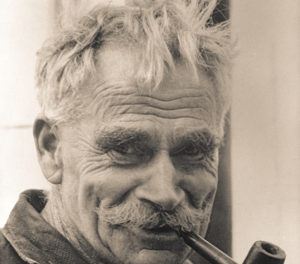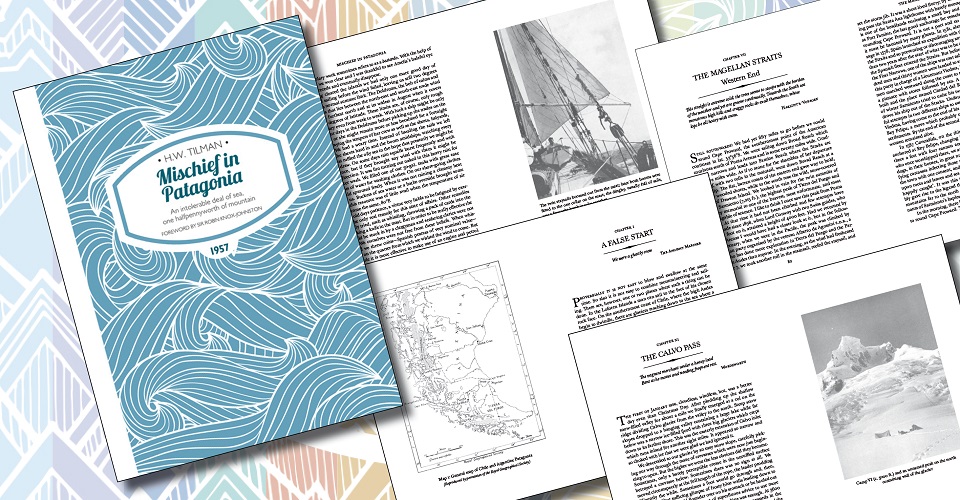 The year was 1955 and H W Tilman was undertaking his first ‘sail to climb’ expedition, aiming to cross the Patagonian ice-cap in both directions—starting from the ‘other side’. This would necessitate a transit of the Magellan Strait; as Sir Robin Knox-Johnston puts it in his Foreword to Mischief in Patagonia: ‘He describes the passage through the Magellan Strait in straightforward terms but, as those of us who have sailed in those channels know, it is a dangerous route with almost constant, cold adverse winds for the west-going vessel, of Force 7 or more.’ Tilman describes this with his usual laconic understatement, but not forgetting to include much topographical detail and local interest—but then, though this was his first voyaging book, he by this time had seven mountain exploration titles to his credit.
The year was 1955 and H W Tilman was undertaking his first ‘sail to climb’ expedition, aiming to cross the Patagonian ice-cap in both directions—starting from the ‘other side’. This would necessitate a transit of the Magellan Strait; as Sir Robin Knox-Johnston puts it in his Foreword to Mischief in Patagonia: ‘He describes the passage through the Magellan Strait in straightforward terms but, as those of us who have sailed in those channels know, it is a dangerous route with almost constant, cold adverse winds for the west-going vessel, of Force 7 or more.’ Tilman describes this with his usual laconic understatement, but not forgetting to include much topographical detail and local interest—but then, though this was his first voyaging book, he by this time had seven mountain exploration titles to his credit.
Now that we were well down in the forties the South Atlantic began to roar to some purpose. No sooner had we left Penguin Isle astern than the coast vanished in a murky haze, while to the south, clouds (which, by the way, I noted in my diary as ‘not very threatening’) began to gather. The gale struck with stunning force. By evening we were running before it to the Magellan Straits north-east under bare poles. But its first fury did not last, for in the course of the night, a glorious night of full moon and cloudless sky, we were able to set the trysail and get the ship once more heading south. By daylight the wind had veered to the north and we got up all plain sail. But again the wind freshened, and again the mainsail had to give way to trysail and storm jib, and later, as she was running too fast, to the jib alone. But at least we were running in the right direction, and Mischief had shewn herself to be such an able sea-boat that we had no anxiety on her account. After two days of better weather, when we were twenty miles off the entrance to the Straits, the glass fell to 29″ and the wind rose. We made our landfall under the conditions which we had now come to regard as specially reserved for such occasions. At 2 a.m. on the morning of 5 November, with a strong westerly gale blowing, we sighted the Cape Virgins light, a little to the north of the entrance to the Straits. Daylight revealed a long, flat line of white cliffs, except for the lighthouse on the eastern extremity bare as the sea itself. The wind was blowing straight out of the Straits and a high, confused sea was running. We could make no westing so we hove to on the starboard tack and drifted slowly southward. In the evening, with no land in sight, we went about to recover our ground and at midnight we once more raised the light. And so it went on. We stood off until the evening of the 6th, when the wind moderating, we shook out all reefs and stood in to the south-west.
Off the entrance to the Straits the tidal streams are strong and confusing; for the flood stream makes north up the coast from round the Horn and also sets east through the Straits, and in the same way the ebb running south divides, part of it setting west through the Straits. So when the wind fell light we started the engine, fully determined that no false pride should stop us entering the Straits and attaching ourselves firmly to the bottom to save our being blown out or set out by the tide. Bernicot, who in 1936 in the cutter Anahita had repeated Slocum’s single-handed circumnavigation by way of the Magellan Straits, had had a rough handling just inside the entrance and was twice swept out to sea in spite of all that sail and engine could do. Slocum, too, had no sooner rounded Cape Virgins than a south-westerly gale struck him and for thirty hours his sloop Spray managed to hold her ground with no more than a three-reefed mainsail and forestaysail. She had no engine and she was not driven out to sea; but then Spray was Spray and there have been few seamen like Slocum.
Inside the Straits the tidal streams are stronger and reach their maximum strength in the First and Second Narrows. In the First Narrows spring tides run at from five to eight knots and are not much less in the Second Narrows. Between the eastern entrance and Punta Arenas a sailing vessel or a low-powered steamer must therefore work the tides, anchoring when the stream is against her. By 10 o’clock that night, when the Dungeness light bore north, we knew we were fairly inside the Straits, and with a nice breeze coming in from north-west and with the flood under us we sailed happily westwards gaining assurance with every mile made good. Early in the morning, when the ebb began to run, we dropped anchor at the tail of the Orange Bank.
Coming on deck that morning with the vague, mysterious coast of Tierra del Fuego on one side and the bold headland of Cape Possession on the other, we felt our adventure had really begun. Until the tide turned we fished unsuccessfully and watched with interest some Commerson’s dolphins. These were the first we had seen; they are smaller than most dolphins with black and white colouring sharply delimited, the white part including the flippers and the lower half of the head. When the flood began to make we weighed and stood towards Punta Delgada at the entrance to the First Narrows. As we neared it the wind dropped so we started the engine and with the tide running full bore we swept through the Narrows with a speed of something like eight knots over the ground. The channel has a least width of two miles, the fairway is deep, and the shores steep-to but not high. An hour later we shot out of the western end and at the same time the engine failed. There was no wind but the tide still ran strongly enough to carry us to a safe anchorage in Santiago Bay.
Instead of pressing on that night with the next tide we took a long night in. At noon next day we weighed again hoping to pass the Second Narrows while it was still light, for at this time of year it is light until after 10 o’clock. No sooner had we started, however, than the wind came in so strongly from dead ahead that we had to push the engine hard to get as far as Gregory Bay, the next anchorage some ten miles to the west. In Gregory Bay there is a frigorifico, a mere collection of buildings with a tall, iron chimney and a wood jetty from which the frozen mutton is shipped. We anchored close off the end of the jetty where only a few children gathered to look at the strange ship, for at this time of year the place was not being used. As if a frigorifico was not a strong enough hint that times had changed we could see, as we looked across the Straits that night, the great flames of natural gas from the oil wells on Tierra del Fuego. Thus the voyager in these historic waters, aglow with such romantic names as Famine Reach, Royal Road, Pelican Passage, or Elizabeth Island (so named by Drake), whose imagination has been stirred and who yet cherishes the hopeful illusion that the low coast on either hand is still wild and strange, must here abandon such imaginings, now utterly extinguished by the horrid reality of a frigorifico on the one hand and of oil derricks on the other.
Expecting to reach Punta Arenas that day we got under way soon after midnight. Since the Second Narrows are much wider than the First the stream is weaker. In our eagerness to be off we rounded Gregory Point and were at the entrance of the channel before the east-going stream had stopped running. Until the tide turned progress was slow, but by five in the morning, when it was full day, we had cleared the western end. As we altered course for Punta Arenas, for the Straits here bend sharply southwards, we met a rare sailing breeze from the north-west. The day was wonderfully clear. To starboard lay Drake’s well-wooded Elizabeth Island, with Queen Channel to the east of it and Royal Road and Pelican Passage to the west. Ahead Broad Reach opened out, its light blue waters ruffled by the freshening wind. Beyond it to the south lay high ground, the slopes green with forest and crowned with patches of winter snow. Far away in the distance, from west round to south, rose a jagged skyline of high mountains, the highest of them glistening with the convincing whiteness of perpetual ice and snow. So unexpected a vision was heartening. There at any rate was country still wild and strange.
As the wind gradually freshened and Broad Reach became covered with white-capped waves, Mischief sped along with a bone in her teeth as if eager to finish in style what had been a rather slow passage. The brown huddle at the foot of a bleak, reddish coloured hillside which we had long decided was Punta Arenas began to take shape. In the roads a big four-masted hulk lay forlorn and uncared for, and soon we could make out the jetty and we had to decide where to go. We were still sailing fast, a little too fast for accurate navigation, and presently a jar and a shudder warned us that Mischief had indeed reached Patagonia. But in a matter of minutes she had bumped over the shoal and we lost no time in handing the sail and dropping anchor a cable’s length from the jetty. A pilot launch was soon alongside and towed us to the jetty where we tied up. We had at any rate astonished the natives. The slight contretemps had gone unnoticed by the ancient mariners and longshoremen who had gathered to see us come in, and who, as we heard later, had much admired our dashing approach, swift rounding-to and stowing of sails. To have made such an impression was gratifying, for it is not every day that an English yacht, or indeed any yacht, comes to Punta Arenas. It was perhaps a pity that our departure was destined to be the reverse of dashing.

